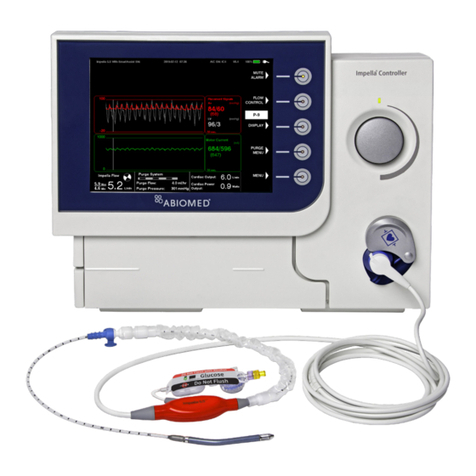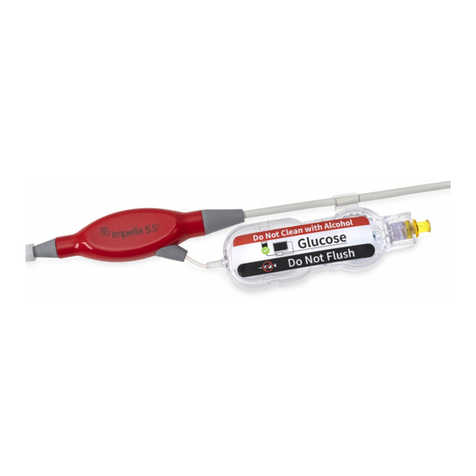
FIGURES
Figure3.1 Impella
®
RPCatheterintheHeart..........................................3.1
Figure3.2 AutomatedImpella
®
Controller,Impella
®
RPCatheter,and
Accessories.............................................................................3.2
Figure3.3 Impella
®
RP Catheter.............................................................3.3
Figure3.4 AutomatedImpella
®
Controller–FrontView........................3.5
Figure3.5 PurgeCassette.................................................................... 3.6
Figure3.6 WhiteConnectorCable.........................................................3.8
Figure 3.7 Introducer kit ......................................................................... 3.8
Figure3.8 0.025inch,260cmPlacementGuidewire............................3.8
Figure3.9 DextroseSolution.................................................................3.9
Figure3.10 AutomatedImpella
®
ControllerCart.......................................3.9
Figure4.1 AutomatedImpella
®
ControllerFeatures–FrontView...........4.1
Figure4.2 AutomatedImpella
®
ControllerFeatures–SideViews..........4.3
Figure4.3 AutomatedImpella
®
ControllerDisplayElements.................4.5
Figure4.4 PlacementScreen...................................................................4.8
Figure4.5 PurgeScreen..........................................................................4.9
Figure4.6 InfusionHistoryScreen........................................................4.11
Figure5.1 AutomatedImpella
®
ControllerPowerSwitch.........................5.2
Figure5.2 AutomatedImpella
®
ControllerStartupScreen.......................5.3
Figure5.3 InitialCaseStartScreen.........................................................5.4
Figure5.4 InsertingthePurgeCassetteintotheAutomatedImpella
®
Controller ............................................................................... 5.5
Figure5.5 InsertingtheCatheterPlugintotheConnectorCable.........5.6
Figure5.6 SnappingPlasticCliptoConnectorCable............................5.6
Figure5.7 PrimingtheImpellaPurgeLumen..........................................5.7
Figure5.8 ConnectingtheLuertotheImpella
®
RPCatheter..................5.7
Figure5.9 EnteringPurgeFluidInformation..........................................5.8
Figure5.10 ConnectingthePurgeTubingtotheConnectorCable...........5.9
Figure5.11 Impella
®
RPSystemConfiguration.........................................5.9
Figure5.12 MaximumPerformanceLevel..................................................5.12
Figure5.13 DisconnectingtheYConnectorfromthePurgeCassette
Tubing......................................................................................5.15
Figure6.1 StudyFlow Schematic …………………………………. 6.3
Figure6.2 Cardiacindexandcentralvenouspressuremeasured
duringthestudy………………………………………….6.8
Figure6.3 LVADflowchangesfrom baselinetoon-support……….6.8
Figure6.4 Useofinotropes duringImpellaRPsupport..…………. 6.9
Figure6.5 Right ventricularfunctionchanges………………………6.10
Figure7.1 AlarmWindow......................................................................7.2
Figure 8.1 AutomatedImpella
®
ControllerPatientEnvironment............8.12
TABLES
Table3.1 Impella
®
RP CatheterComponents ..........................................3.3
Table3.2 PurgeCassetteComponents .................................................... 3.7
Table3.3 Impella
®
RPCatheterandAutomatedImpella
®
Controller
Accessories.................................................................................3.8
Table4.1 AutomatedImpella
®
ControllerFrontViewFeatures..................4.2
Table4.2 AutomatedImpella
®
ControllerSideViewFeatures...................4.4
Table4.3 AutomatedImpella
®
ControllerDisplayElements.....................4.5
Table5.1 PerformanceLevelFlowRates.................................................5.13
Table6.1 Patient Characteristics...............................................................6.4
Table6.2 BaselineLaboratoryParameters………………………….. 6.5
Table6.3 ProceduralCharacteristics …………………………………6.6
Table6.4 SupportandHemodynamicCharacteristics ………………. 6.6
Table6.5 Patient Outcome …………………………………………… 6.7
Table6.6 SecondarySafetyEndpoints ………………………………. 6.7
Table7.1 AlarmLevels..............................................................................7.1
Table7.2 AutomatedImpella
®
ControllerAlarmMessages .....................7.3
TABLEOFCONTENTS


































